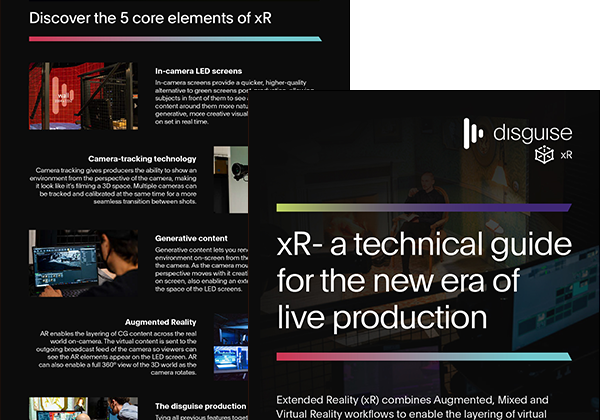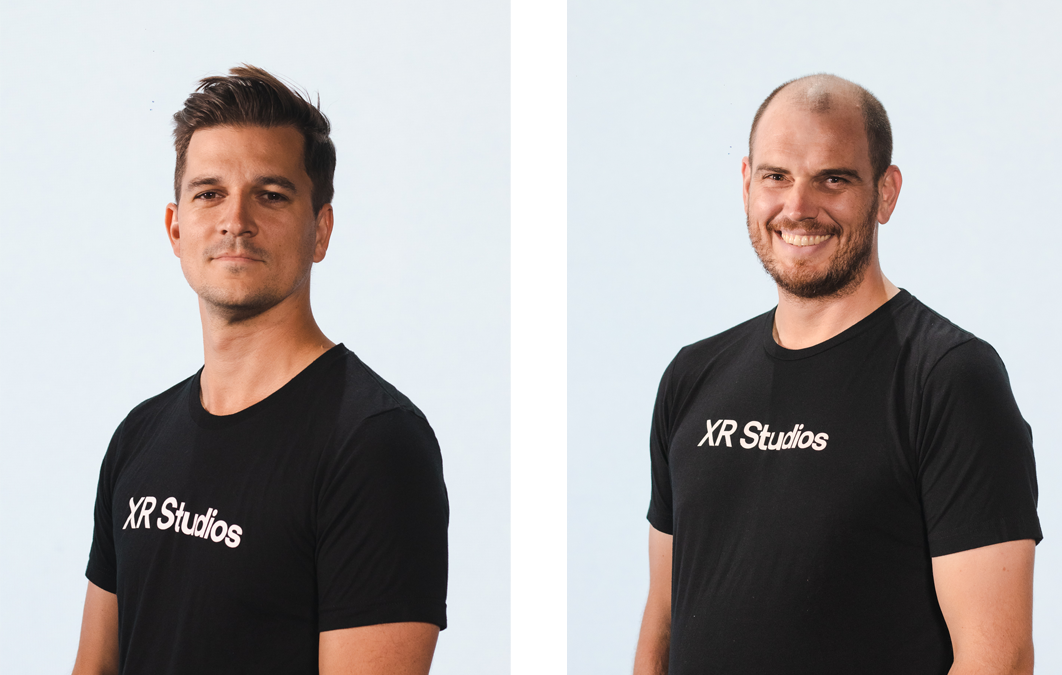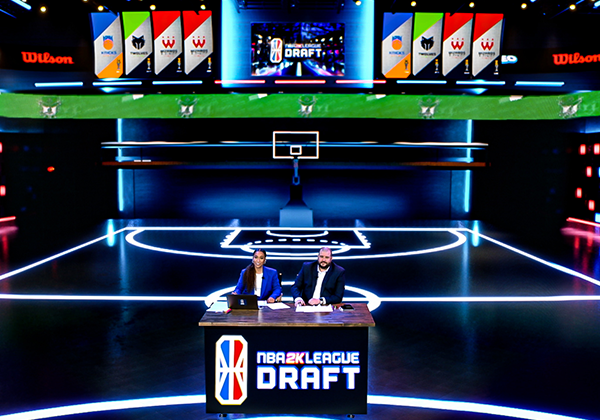
blog 2022 10 min read
Community spotlight: J.T. Rooney & Scott Millar, XR Studios

What happens when two of the most well-known names in the disguise community bring their skills and knowledge together? They build an organisation that becomes synonymous with the soaring popularity of extended reality (xR) powered by disguise. Meet J.T. Rooney and Scott Millar of XR Studios – the company responsible for some of the most spectacular xR productions from the past two years, including Camila Cabello’s 'La Familia' album launch concert on TikTok and Billie Eilish’s ‘Where Do We Go’ livestream with Moment Factory.
J.T. Rooney and Scott Millar met at Live Design International in 2018 during the launch of the disguise gx 2, before crossing paths again to collaborate for the first time on the Super Bowl LIII Halftime Show in 2019. Their next venture saw them drive the first mainstream xR project that would change the face of live events and xR production forever: Katy Perry’s memorable performance on the American Idol 2020 Season Finale.
Below we catch up with the two on their journey with XR Studios so far.
How did your collaboration and the creation of XR Studios come about?
Scott Millar, Chief Technology Officer: When I first met J.T., I saw the great things he was doing at Silent Partners Studio, pushing the boundaries with disguise, driving the technology forward on what can be done at shows and live entertainment. It was a bit of a coming together of our paths, and the timing of it was during COVID. As bad as the pandemic was for the world, it allowed J.T. and I to finally do a project together, even when we were over 6000 miles away from each other. That project happened to be Katy Perry’s American Idol Finale performance – and the rest, as they say, is history.
J.T., XR Studios President: When the Katy Perry performance came around; I knew we had to work with Scott on this in order for it to be successful. The formation of XR Studios came then as well, and our collaboration started and continued throughout all of COVID, with Scott incredibly working on 25+ shows remotely from London during that time.
What inspired you to pursue xR officially at such an early stage in its development?
J.T.: xR was on both of our horizons in different ways, as it was for many people in the entertainment industry. Real-time rendering became a real focus for me since 2014 or so, from moments of realising the benefit of real-time for reactivity and interactivity. When working on Katy Perry’s SuperBowl Halftime Show in 2015, Ash Nehru (disguise founder) and I were looking into doing perspective-corrected content during the broadcast, as the projection was already placed from one perspective for the audience. The idea was there, but the technology just wasn’t quite aligned yet, so we stuck with one decided perspective at the time. However, the seed was planted with Ash and the disguise team – as well as some others in the community – to keep pursuing this as a creative tool. Years later, multiple projects started to become pitched for this workflow, – even before it was ready – after seeing some early successes with the team at Notch, Bild, Fred Waldman and folks in the film community, and early adventures from Phil Galler and the Lux Machina team in film projects.
Scott: I’ve always wanted to get into the world of film and xR, alongside the live events projects I’d mostly been working on. Opportunities started coming up with this through Bild Studios, which I started with David Bajt and Rowan Pitts after we made and published a number of videos showing experiments we’d been working on. Our first large-scale show was the Pakistan Super League opening in Dubai. This had stadium scale AR for the first time, and set the course and proved that we had the skills and knowledge to push these boundaries. It was then with my work alongside White Light and Andy Hook, who was driving new broadcast experiences with disguise, that I was able to be involved from the inception and really be a part of the development, believing that from all the crazy ideas there was a viable product out there that clients would want and it was worth investing our time in.
What have been some of your proudest moments with XR Studios so far?
J.T.: The Katy Perry American Idol performance from two years ago still stands out as a special moment, partially because it was really one of the first times xR had been executed on a very large, national, pop-star scale, but also because it was a really creative use of the technology. Although there had been other uses of the tech in more corporate or sports or technical uses, this was a real moment in time where there wasn’t much else happening in the creative performance space due to COVID, and it was additionally just something new.
Another proud moment was the 2020 Video Music Awards with MTV. Taking this technology to a whole new stage and creating the hosting environment as well as a large amount of the performances, on a show that is already challenging and at a high level, was a real feat. Creating a multi-camera switched environment at that scale, with a massive LED stage built for the show, and making a system that allowed screen producer Trevor Burk to keep his workflow and management of this massive show, was a special moment and a great step forward into the future of broadcast technology.
Scott: The first xR show I put on, through my own company in partnership with Pixel Artworks, was a very special moment. We were tasked by AKQA and their client HP Omen to deliver the HP Omen Challenge tournament. I remember having to hold back my excitement in the first meeting when they, without prompt, described ‘a crazy idea’ that happened to be a perfect fit for xR. It was a huge undertaking, many late nights and using a very early version of xR. To this day though, there still hasn’t been such an immersive eSports xR shoot, nor a live broadcast using two xR stages at the same time. The second one I’d love to mention was the Kid Cudi ‘Man on the Moon’ concert for the Amazon Prime Day Show. It was the culmination of a year of development from disguise, and a year of internal development at XR Studios. We were able to bring all the ideas, dreams and fixes we knew needed to be built to that show and it really came together. It was a real ‘this is incredible’ moment for me.
What sets your studio and skills apart?
J.T.: From the beginning, XR Studios was created to fill a gap in the market, and really focus on having a full-service studio specifically for this technology and workflow. Our studio is always set up and ready to go, and it is calibrated constantly, so the clients are not sitting and watching a stage being built. Our space is set up very specifically, down to where people sit and watch and participate, so crew members have the most efficient way of working and the ability to quickly focus on the creative process and not the technology. In addition, the team is constantly working outside the box creating new and custom tools and software to help make the most efficient workflow possible. These tools help us keep our competitive edge, but also the approach has allowed us to partner and work with disguise to improve the software, test it on a large scale and with massive projects, and benefit the rest of the growing industry with these updates.
Scott: From a technology perspective our main driver is to create a space where the technology is not seen, only used. We want to make sure that people don’t get overwhelmed by everything going on, and can focus on their creative needs and ideas. Making a solution that is, on one hand, bleeding edge, while on the other, no different from a traditional studio experience, is a big challenge that we believe we’re leading the way on.
How has disguise supported you and your team since the beginning of XR Studios?
J.T.: Scott and I both have long histories with the team at disguise and those relationships are key to making this workflow grow and change. Having spent years collaborating with the disguise team to make new features, figure out difficult challenges on large projects, and find their space in the entertainment market, the relationship created a tight support at the beginning of XR Studios. The initial Katy Perry American Idol project was realistically something that was pushing the boundaries of what anyone thought was possible by a magnitude of months of development. Although the xR solution had been around and starting to be used, the number of features, corrections, bug solves, and just sheer development needed to achieve that show, took a great amount of work and dedication from the disguise team. Add to the overall factor that it was in the height of COVID and teams were spread across different locations, time zones, and access levels, it really created a unique challenge.
After this, XR Studios and disguise got into a rhythm of pushing the boundaries and creating new features and fixes for each show, as the bar continued to be lifted with each project. The 45-minute livestream for Billie Eilish with Moment Factory in 2020 was a big jump into using the workflow in a live-broadcast environment, while transitioning through a dozen or so extremely ambitious environments and scenes. All of the projects like this one took new features and realisations as to what the entertainment and broadcast market would need if this tool was to come to fruition and mature.
Scott: I’d like to think that our team and the disguise team are one and the same when we work together to drive this technology forward. Our experiences with large-scale productions are not something that can be replicated in the lab, nor can we have the development knowledge and insight that disguise has. Mixing these two worlds, with trust and understanding of each other’s business, has allowed us to satisfy our clients’ creative needs along with helping disguise develop technology which has helped the entire industry.

From L-R: J.T. Rooney and Scott Millar
What’s next for XR Studios?
J.T.: XR Studios is excited to be moving into our new Hollywood XR Campus in the fall. Our offices are already occupied and we’re creating a great creative and collaborative space for companies and creative teams to work together. While we are currently doing shoots in our temporary boutique setup at Sunset Studios Las Palmas, the teams are working on the final install and construction of our two-studio setup at the XR Studios Hollywood Campus. These two setups will allow flexibility and modularity so that large-scale productions and small projects alike can use the space, and get to a place where it is a more and more traditional and known workflow for entertainment projects in Hollywood.
An additional exciting part of the Hollywood Campus is the screening room and entertainment facilities in our office section, which is in the historic Eastman Kodak building. This theatre and connected areas will be used for community events and gatherings, including panels, presentations, product releases, screenings, cocktail hours and meet and greets, and many more things to come, which will be an exciting part of getting the community back together in person after a long few years apart.
Scott: We want to make sure that we stay at the forefront of the development in a way that’s actually usable and accessible to our clients on productions. There are a number of parallel technologies, such as in-camera AR, and even in-person AR, that are respectively here now and just over the horizon, that we want to help lead in the next decade.
Read more about our collaborations with XR Studios:

